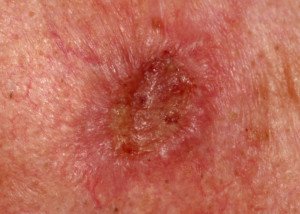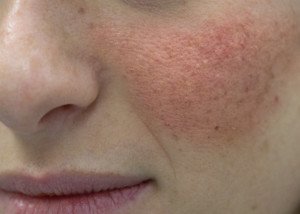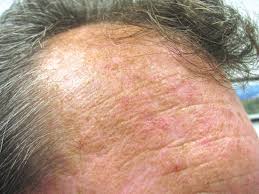Actinic keratoses and squamous cell carcinoma can look similar; in fact, an actinic keratosis can turn into a squamous cell carcinoma.
Some doctors even believe they are one and the same, just at different points along the continuum.
Squamous cell carcinoma is the second-most common skin cancer. About 3,500 people in the U.S. die from it every year.
This skin malignancy grows slowly, but the deadliness lies in the delayed diagnosis.
The delay means that five percent of squamous cell carcinoma spreads, and this is what makes it lethal. As it grows locally, the destruction can become quite gruesome.
How common is squamous cell carcinoma?
Every year in the U.S. there are 250,000 new cases. Though this disease is strongly tied to sunlight exposure and usually grows in heavily exposed areas to the sun such as the face, scalp and limbs, it can actually grow in dark areas such as under the tongue.
Skilled Mimicker of Normal Aging Skin
Squamous cell carcinoma often initially masquerades as what many people might pass off as benign aging of the skin.
People may see that slowly developing dark pink, scaly patch of skin as a harmless consequence of getting older, or even harmless sun damage or the non-cancerous but abnormal actinic keratosis.
The individual may end up completely ignoring the stealthy growth, becoming desensitized to it, especially if he or she has already been diagnosed with similar-looking benign growths. Skin cancer never enters their minds.
The diagnosis of squamous cell carcinoma is on the rise in people under 45.
What Squamous Cell Carcinoma Looks Like
- Patchy area of skin, reddish or pink in color.
- Often scaly and/or crusty. The crust may be some shade of brown or brownish yellow.
- May also take the form of unsightly nodules or very raised bumps, sometimes with a horn-like structure sticking out of them.
- If growth is allowed to progress enough, the area can become quite “gross” in appearance.
Actinic keratosis (below), which is very common, results from sun damage, and if left untreated, 5-10 percent of these morph into squamous cell carcinoma.
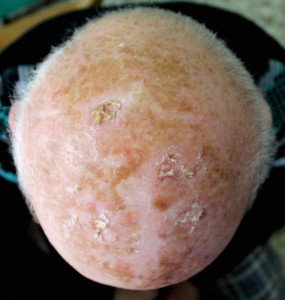
Shutterstock/Dermatology11
I asked Jason Lupton, MD, how a doctor can tell the difference between actinic keratosis (which many people have but don’t realize it) and early squamous cell carcinoma.
Dr. Lupton is a board certified dermatologist practicing in the San Diego, CA area.
Dr. Lupton: Sometimes it is hard to distinguish between AK and early SCC. This is sometimes determined by response to treatment — if a lesion responds to basic treatment — liquid nitrogen or topical therapies — then a further pursuit is unnecessary.
If it does not, then the lesion is biopsied to determine if it has changed over into a squamous cell carcinoma.
Typically SCC’s feel more pronounced, a little bumpier, rougher and bleed more easily and are just more “hearty” lesions — although again, this is not exact.
A squamous cell carcinoma is also more likely to be tender or feel — to the fingertips — as though it has some substance beneath it.
Can squamous cell carcinoma develop from a mole?
I have never heard of an SCC developing from a mole. It derives from the squamous epithelium. They are different entities.
Since squamous cell carcinoma is tied to sun exposure, how is it that it can develop inside the mouth or anus?
SCC is related to sunlight exposure, but in those other areas it is associated with preceding HPV infections. So sunlight is not everything with this type.
If you suspect you have only an actinic keratosis, you should see a dermatologist just to be sure.
To prevent this from morphing into squamous cell carcinoma, your doctor will spray it with liquid nitrogen (cryotherapy) which should kill the atypical cells.
If there’s no response, a prescription cream can be applied.

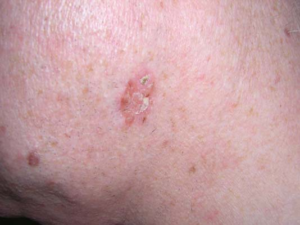
 Dr. Lupton
Dr. Lupton